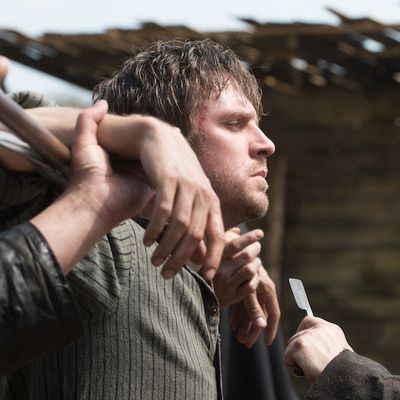
If you know the name Gareth Evans, it’s probably because you’re a fan of the meticulously choreographed, almost impossible to comprehend martial-arts sequences that defined his breakout features The Raid: Redemption and The Raid 2. Born in Wales, Evans made a name for himself making action movies in Indonesia — really the exact path you’d expect from a young boy in the Welsh valleys who dreams of filmmaking one day. His latest picture, Apostle, is his first English-language feature since his debut film in 2006, and it stars Dan Stevens as Thomas Richardson, a man who goes off to retrieve his sister after she is abducted by an island-dwelling cult led by Michael Sheen’s Prophet Malcolm.
Set in the early 1900s amid a provincial settlers’ colony, Apostle is the kind of movie you can smell, and even though Evans wanted to get away from the combat spectaculars of his Raid films, his training in action has helped hone a keen eye for shot sequencing. When the intensity ramps up in an Evans film, you feel immersed in the scenes, and in one of Apostle’s most savage runs, that deft hand is on display as Stevens fights with a basket-headed man they call the Grinder who’s trying to run him through a — well, through a meat grinder.
“I didn’t want to make an action film for sure,” says Evans of his folk-horror story, which draws inspiration from British occult horror classics like The Devils and The Wicker Man. “I said to [Dan] from the get-go, ‘You’re not going to be doing action in this movie. You’re going to endure a lot.’” And endure he does. The mangler scene was shot over multiple days, during which dozens of seconds-long shots were filmed to be stitched into one grueling battle. Stevens spent much of it covered in fake blood and actual mashed bananas that were painted onto his body to make him appear coated in grime. To get a fuller understanding of how it all came together, Vulture spoke with the star and the director about filming a fight scene that’s built for a horror movie instead of an action one. Here’s how that brawl came to life.
Don’t Make an Action Movie
“I’m known for doing sort of martial-arts films,” says Evans. “So usually when it comes to choreographing a sequence of action, you’re bound by the limits of the human body. It’s punches or kicks or weapons-based scenes, and it’s very straightforward sometimes, because there’s only so many ways you can punch, kick, throw, and block.” In the case of the mangler skirmish, the blocking revolves around a simple death contraption that Stevens characterizes as a kind of meat mincer. And going up against his basket-headed opponent, the character of Thomas ends up in more of a street brawl than a smooth fistfight, getting roughed up on a man-sized table as a witch’s imp attempts to turn him into ground beef.
Together with his action sequence designer and fight choreographer Jude Poyer, Evans and the team labored over the mechanics of the machine itself, determining how various counterweights and levers would work in action, knowing that the strength of the scene rested on Thomas being perilously close to its churning gears, and the audience believing he might get ripped to pieces. It helped sell the fiction that Thomas’s opponent, the Grinder, looked like something straight out of a scene from Silent Hill. “This guy was standing just caked in fake blood with a basket over his head the whole time,” says Stevens. “He was an amazingly good sport. We got really physical with this fight, and having the basket on the head means that you can kind of get nasty with some of the hooks and things.”
Humanize the Hero
One of the things that makes Evans’s Raid films so spectacular to behold is the near-invincibility of its star, played by actor, stuntman, and martial-arts master Iko Uwais. But Evans wanted a protagonist more battle-weary and broken down than Uwais’s video-game-style heroes. “I wanted Thomas to the appear weak, vulnerable,” says Evans, who knew Stevens could handle himself after seeing him in The Guest. “I want him to not be in control of the situation, and I think that weakness and that vulnerability is what keeps us on side with him. He has a perseverance to him and the ability to endure through all the sort of arduous hardships that we put him through in this movie.”
The threat of mortality is especially credible, too, considering by the time the mangler scene comes around, you’ve already watched a man get his brain cored out with a hand-cranked drill. Even if Thomas makes it off the table alive, you get the feeling he might have to sacrifice a limb to make it happen.
Prepare Extensively and Shoot Small
Evans spent months in preproduction mapping out every action sequence with Poyer, and together in a room filled with crash mats and boxes they would “literally shoot it like it would appear in the film. Just go through it, shot by shot, edit by edit, and then that becomes the framework by which we would shoot the actual final version on set with all the props and all the bells and whistles.”
With everything so specifically designed ahead of time, Evans could then communicate to all his actors and department heads exactly what would be needed in every scene. “Gareth is amazing at just shooting specific, tiny seconds of shots,” says Stevens, whom Evans admits went “through the ringer” for Apostle. “He’ll never shoot the whole fight. I don’t think we ever once ran it beginning to end, and the reason you can come at these fights with such energy is because they break them down, shot by shot by shot, so he knows exactly where the moment of storytelling impact is gonna be.”
In addition to preserving his performers’ energy, Evans also likes the clarity that comes from stitching together an array of short shots. It makes for a lot more setups, but the action is ultimately more crisp and easy to follow. “I never shoot action in terms of just getting wide coverage of it,” explains Evans. “I always shoot very specific shots that are like jigsaw pieces, so they’ve all gotta connect together. What I think helps a lot is the performer gets to focus just on the three or four seconds worth of action. They don’t have to burn themselves out doing all of it all from the beginning till the end — repeat, repeat, repeat — until their legs can’t take it anymore.”
Go a Little Too Far
After a lengthy showdown, Thomas does finally succumb and loses some fingers to the mangler, meaning he has to finish his opponent off with a few bloody stumps on one side. The audience keeps thinking Thomas will pull back in time, but it was important to Evans that his audience know there were no rules. “We kept talking about it. ‘Is he really going to lose the hand in there?’ And I was like, yeah, because the audience is gonna constantly think, ‘It’s Dan Stevens. He’s not going to lose anything. He’s going to break free,’” Evans says, recounting the scene. “And I’m like, ‘No, he’s not. He’s going to break free from it when he has to give up half of the hand.’ So that was a fun part, playing on the expectations of the audience coming in to see Dan in a movie, and once you see that happen, all bets are off.”
And Stevens, covered in dirt and starting to smell after days of being painted with smashed bananas, showed up for his director every day. “To be honest, he was such a good sport and such a champ throughout,” says Evans. “Usually on a film you might have one sequence that sort of tests your patience in an uncomfortable environment. We had about six or seven for him in this movie. So he was a legend. I think everyone came away with a massive amount of respect and love for Dan on set there.”





